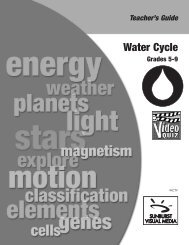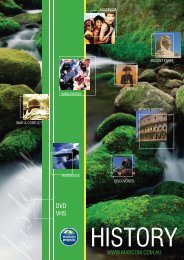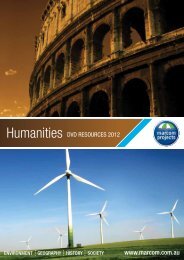Thrilling Experiments: Potential and Kinetic Energy
Thrilling Experiments: Potential and Kinetic Energy
Thrilling Experiments: Potential and Kinetic Energy
You also want an ePaper? Increase the reach of your titles
YUMPU automatically turns print PDFs into web optimized ePapers that Google loves.
Script<br />
46<br />
CAST<br />
Tony “Thrill” Hill ..............................................................host<br />
June Sifuentes ......................................................experimenter<br />
Chris ............................................................................volunteer<br />
Frankie ........................................................................volunteer<br />
Ashunta ......................................................................volunteer<br />
TONY<br />
Welcome to <strong>Thrilling</strong> <strong>Experiments</strong>. Hello, I am Tony “thrill” Hill <strong>and</strong> I hope you are<br />
as ENERGETIC as I am because we are going to be doing some very thrilling<br />
experiments on ENERGY.<br />
But first we need to know what energy is <strong>and</strong> why it is so important. <strong>Energy</strong> is the<br />
ability to do work. Work involves a change in position, movement, if you will. Any<br />
object that has energy, <strong>and</strong> moves or changes position, is working.<br />
For instance, the oil in a diesel engine that helps it run is a form of energy.<br />
A bulldozer pushing s<strong>and</strong> is also a form of energy. There are 5 types of energy.<br />
Mechanical, heat, chemical, electromagnetic, <strong>and</strong> nuclear. The oil in the diesel is a<br />
form of chemical energy. The bulldozer is a form of mechanical energy.<br />
One of the first scientists to work with energy was Albert Einstein. In his studies,<br />
he came up with a formula. You may have heard of the theory of relativity. You<br />
know, E= MC?. You know, energy is equal to mass times the speed of light squared.<br />
In his revolutionary theory, Einstein stated that mass (M) <strong>and</strong> energy (E) are<br />
interchangeable. He said that mass was a form of energy, <strong>and</strong> even more, that a<br />
little mass was equal to a lot of energy. His theory also followed the law of<br />
conservation of energy. And everyone knows what the law of conversation of<br />
energy says, right?<br />
The law of conservation of energy states that energy can be changed from one<br />
form to another, but cannot be created or destroyed. This is happening all around<br />
you. Look in your house. Electrical energy to heat your house is a form of<br />
electromagnetic energy <strong>and</strong> the light energy inside your toaster, which toasts your<br />
bread, is a form of heat energy.<br />
<strong>Thrilling</strong> <strong>Experiments</strong>: <strong>Potential</strong> <strong>and</strong> <strong>Kinetic</strong> <strong>Energy</strong> © Sunburst Visual Media, a division of Global Video, LLC











